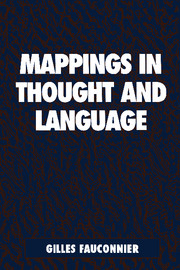6 - Blends
Published online by Cambridge University Press: 05 June 2012
Summary
Thought and language, I have been arguing, depend among other things on our capacity to manipulate webs of mappings between mental spaces. This book started out with general evidence for such mappings and went on to the local construction of spaces and connections in everyday discourse, including the elaborate tense and mood systems that language uses to guide us through mazes of interconnected spaces. In Chapter 4, we saw another dimension of the cognitive operations we perform on such structures: the analogical links and inference transfers within space configurations. All forms of thought are creative in the sense that they produce new links, new configurations, and correspondingly, new meaning and novel conceptualization. In this chapter, I give an overview of one important cognitive process that drives some of this creativity and depends crucially on cognitive mappings between mental spaces. The process, conceptual blending, is studied in some detail in Fauconnier and Turner (1994,1995), Turner and Fauconnier (1995,1996), Coulson (1995), and Mandelblit (1994,1995).
Principles of Blending
Blending is in principle a simple operation, but in practice gives rise to myriad possibilities. It operates on two Input mental spaces to yield a third space, the blend. The blend inherits partial structure from the input spaces and has emergent structure of its own. Here are some of the conditions that are satisfied when two Input spaces I1 and I2 are blended:
(1) CROSS-SPACE MAPPING: There is a partial mapping of counterparts between the input spaces hI1 and I2, as shown in Fig. 6.1.
Information
- Type
- Chapter
- Information
- Mappings in Thought and Language , pp. 149 - 186Publisher: Cambridge University PressPrint publication year: 1997
